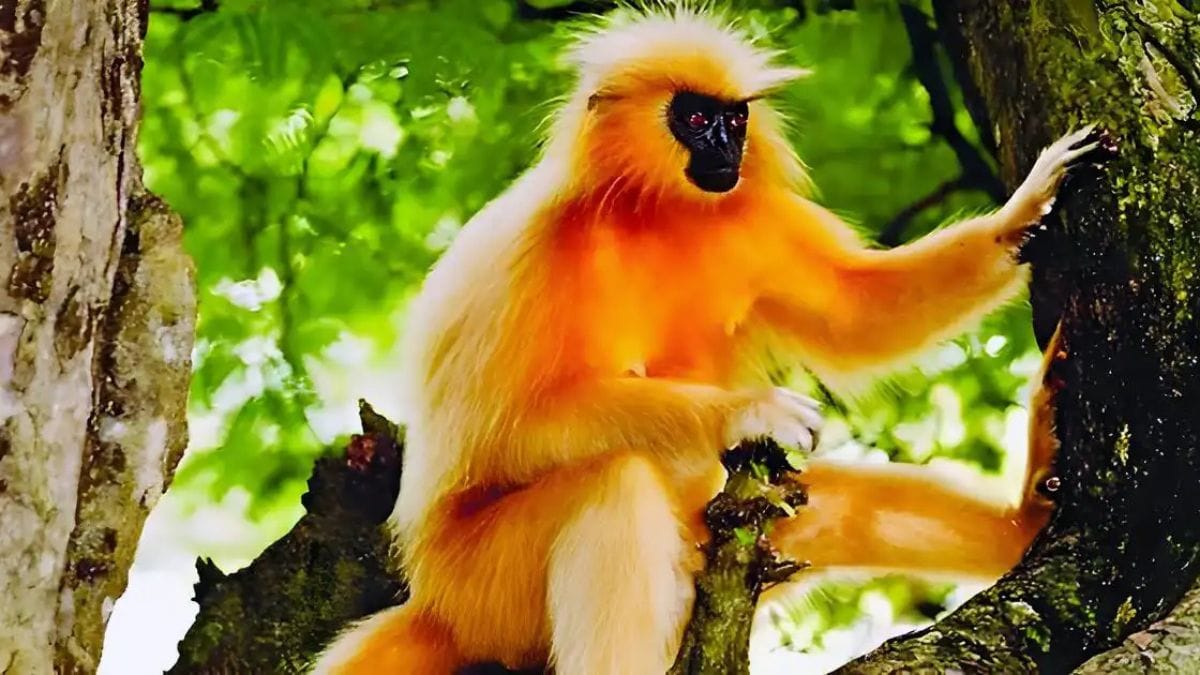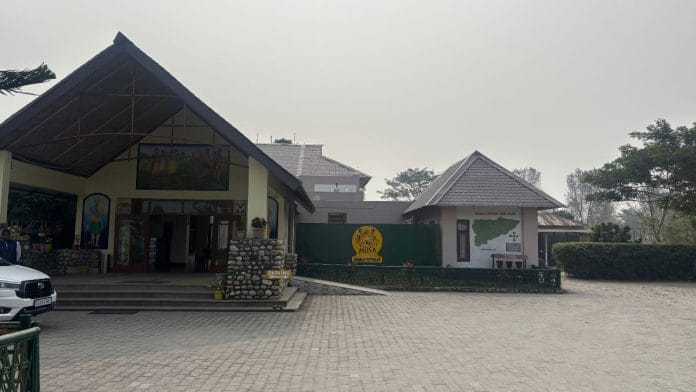Kokrajhar: The sun’s rays hit a flaming patch of gold in a thicket of green, revealing Bodoland’s pride – the endangered golden langur. Leaping playfully in a canopy of Sal trees, it’s the autonomous Assamese region’s living postcard to the world. A marker of the Bodoland Territorial Region’s baby steps toward eco-tourism — and an insurgency-free future.
Five years after a tripartite agreement that paused decades of separatist unrest, peace seems to have returned to Bodoland. However, remnants of insurgency and neglect linger – no public transport, ATMs, or restaurants for miles on end, and bumpy roads that make short journeys seem unending. But this region in Assam, governed by the Pramod Boro-led Bodoland Territorial Council (BTC), is determined to flip the narrative. Tired of being labelled ‘slow-moving’ and ‘disturbed’, Bodoland is now rewriting its story to claim its place on the map.
The BTC is on a mission to transform the long-sidelined region into a development hub while carefully preserving its fragile, hard-earned peace. From setting up space labs in schools to building IT parks and hosting football cups and literature festivals, the council is now looking to catapult Bodoland into national consciousness. At the heart of this transformation push is eco-tourism, which aims to showcase Bodoland’s national parks and GI-tagged items while economically empowering the Bodo community.

“While our tourism sector is in its nascent stage at the moment, we are already training our youth in hospitality management, and strengthening our tourism department. We are preparing for infrastructure development, and have dedicated Rs 160 crore to tourism development from the Rs 1,500 crore package we got from the central government,” BTC’s Chief Executive Member Pramod Boro told ThePrint. Boro is even seeking inclusion in Article 280 of the Constitution to get more funds for the development of remote areas most affected by insurgent activities.
It’s a tall order for a region that even people from Assam have been scared to visit. Even though Bodoland has signed three agreements across three decades – in 1993, 2003 and 2020 – peace has remained largely elusive. According to Assam Chief Minister Himanta Biswa Sarma, development in Bodoland is a gradual, continuing process. “Twenty-thousand-odd people have died here. It’s just three-and-a-half years of Modi charisma…before this, I would have been asked ‘How many grenades have you found, how many bomb blasts have happened, how many people have died’…” Sarma told journalists in Kokrajhar, at a public gathering marking five years of the 2020 Bodo Peace Accord.
- What is Bodoland famous for?
Bodoland is known for its national parks, eco-tourism, and GI-tagged textiles like the dokhona saree. - How is Bodoland promoting tourism?
The Bodoland Territorial Council is investing in eco-tourism by developing parks, training hospitality workers, and boosting GI-tagged products.

Also read: Bodoland witnessed new wave of growth after Peace Accord: PM Modi
Boosting eco-tourism
Melting into the verdant, rolling hills of Bhutan, Kokrajhar’s Raimona National Park teems with wildlife—from spotted deer and peacocks to elephants and golden langurs. While its rangers are quite new to their jobs and the park infrastructure in its early stages, Raimona is gunning to become Bodoland’s eco-tourism hotspot.
“We already have 10 gypsies, 12 homestays, and four resorts in Raimona,” said Somnath Narzary, chief advisor of the Raimona Golden Langur Eco-Tourism Society. His NGO is encouraging unemployed Bodo youth to become “tourist guides, gypsy drivers and help run homestays and resorts”.
Narzary’s efforts haven’t been in vain. “We are getting tourists from not just Assam but abroad – America, Canada, Japan, and Vietnam. Raimona even welcomed a research scholar from the University of Texas, and student researchers from Guwahati, Dibrugarh and Tezpur universities keep coming here,” he said. His organisation also partnered with the government to reform and rehabilitate 57 former poachers, who are now helping preserve the same ecosystem they once exploited. Although, according to a former poacher ThePrint spoke to, the government’s one-time settlement of Rs 50,000, given in 2021, hasn’t done much to alleviate their financial distress.

But the Bodoland Territorial Council remains on the move – eager to speed up development work and beckon more domestic and international travellers. While the infrastructure isn’t fully ready, the region has already started seeing more tourist footfall. As per data from the BTC’s Department of Tourism, domestic arrivals increased from 51,391 in 2021-22 to 59,413 in 2022-23 and 60,127 in 2023-24. International arrivals, on the other hand, rose significantly from just 33 in 2021-22 and 816 in 2022-23 to 1,493 in 2023-24.
“Bodoland, known for its rich cultural heritage and natural beauty, is being promoted as a hub for eco-tourism, cultural tourism, and adventure tourism through sustainable, community-driven initiatives by actively implementing several strategies to enhance its image,” said a spokesperson from the tourism department.
Among these strategies is the cultivation of flagship attractions – Manas National Park, Raimona National Park, the Sikhna Jwhwlao National Park, the Chakrashila Wildlife Sanctuary, and Bogamati, a popular picnic spot.
“The department is actively publicising these locations, while ensuring visitor-friendly amenities by training the service providers, introducing activities and promoting sustainable practices to preserve biodiversity,” said the tourism department spokesperson. In Raimona National Park, they added, “river rafting training has been imparted as an additional activity for the tourists, and Manas National Park is being promoted as a hotspot for wildlife safaris and bird watching.”

Growing hospitality
The growth in eco-tourism is a shot in the arm for Bodoland’s budding hospitality industry. For Krishna Pathak, a gypsy-driver-turned-homestay-owner at Manas National Park, it symbolises transformation. “Life was difficult earlier – we could only do farming, or worked as migrant labourers. The gradual influx of tourists changed things for me. It allowed me to open a homestay in 2017, and expand it from just two rooms to nine over the years,” recalled Pathak, who grew up navigating the park’s rich biodiversity.
Near Pathak’s humble homestay stands the grand Musa Jungle Retreat, run by Mrinal Basumatary and his partners at Olongbar Hospitality. While the lack of tourist footfall affected his business initially, it now employs 28 people – including eight women – who are all Bodos. “The insecurity being felt earlier is no more. Because of the peaceful atmosphere here, people are now feeling that it is safe enough to go there [Manas National Park],” said Basumatary, who is also the president of Manas Accommodation and Tourism Society (MATS).
From tourism fairs to sponsorships, the BTC government’s interventions made it possible for hotels and homestays to grow around Manas, he claimed. “Before Covid-19 and the 2020 peace agreement, there were just 12-15 properties here in Manas. Now, there are over 52.”
The initiatives to ensure this uptick continue. “The BTC government has recently adopted a village outside Manas’ boundaries, which it is developing into a tourism village,” added Basumatary, whose MATS works to promote sustainable tourism by strengthening the hospitality infrastructure around the park.
Despite the lingering anti-outsider sentiment, tourism is a symbol of hope for the young people of the Bodo community, said Krishna Pathak. “Some people are still wary of tourists here, but most welcome them because their arrival has allowed them to chart a new path in life. Young men and women are increasingly joining cooking and guide-training workshops to become a part of the industry.”
Also read: Assam govt has eco-tourism plans for Deepor Beel, a Ramsar site. But residents fear ecological cost
GI tag push
Women wrapped in vibrant, six-cornered Dokhona sarees move swiftly through the lanes of Kokrajhar – laughing, talking and blissfully unaware of their attire’s new-found significance. The Dokhona saree and traditional handwoven garments such as Jwmgra, Gamsa, and Aronai, are among 21 Bodo items that received a Geographical Indication (GI) tag in 2024.
The Bodoland Silk Park – backed by the BTC, Central Silk Board, and Ministry of Textiles – aims to boost the production of these GI tag items, which include Bodo Eri silk. A budding tourist attraction developed by Bodoland’s sericulture department, it’s equipped, among other things, with a cocoon bank, an Eri spun silk mill, a silk printing unit as well as knitting and embroidery units. Most importantly, it’s part of a larger push to reform sericulture’s image as “a poor man’s occupation” and generate employment for 40,000 silkworm rearers and 10,000 weavers, many of whom are rural Bodo women.


The momentum continues with the sericulture department’s Bodoland Handloom Mission, which hopes to boost the production of GI-tagged textiles. “We have opened 20 clusters with around 6,000 weavers. We are imparting training to them, and also have been distributing handlooms so that they can weave products that we can finally take to the market. It’s still a work in progress, and I hope we can achieve a lot more from this mission in the coming years,” said Raktim Buragohain, BTC’s sericulture and handloom secretary.
But for Buragohain, these initiatives and achievements hold more than just economic significance.
“The GI tag is a recognition of the continuous struggle that had started in Bodoland right from the pre-Independence era for gaining its identity. It might not be able to bring in any commercial benefit, but it’s an acknowledgement of Bodo identity.”
The author visited Bodoland on the invitation of BTC.
(Edited by Ratan Priya)







Massive scale illegal immigration from Bangladesh has endangered the very existence and culture of the Bodos – an indigenous minority community in Assam and Meghalaya.
Illegal Muslim immigrants from Bangladesh must be identified and deported at the earliest.